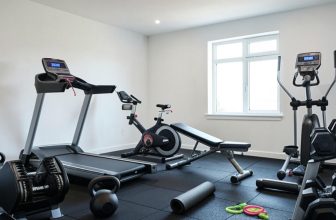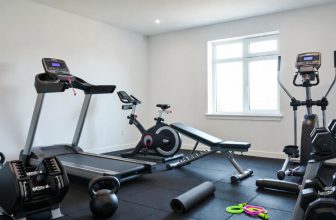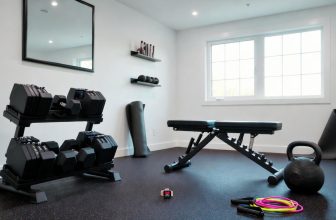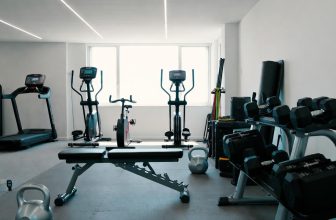Table of Contents
- Are Exercise Bikes or Treadmills Better?
- Exercise Bikes: Benefits and Features
- Health Benefits of Exercise Bikes
- Calorie Burn and Weight Loss
- Practical Features
- Treadmills: Benefits and Features
- Health Benefits of Treadmills
- Calorie Burn and Weight Loss
- Practical Features
- Comparing Exercise Bikes and Treadmills
- Joint Health and Injury Risk
- Fitness Goals
- Cost and Space Considerations
- Who Should Choose Which?
- Ideal Candidates for Exercise Bikes
- Ideal Candidates for Treadmills
- Safety Tips for Both
- Exercise Bike Safety
- Treadmill Safety
- FAQ Section
- Final Thoughts
- About Author
- Mariar Fernandez
As an Amazon Associate, I earn from qualifying purchases.
Are Exercise Bikes or Treadmills Better?
Are Exercise Bikes or Treadmills Better? Neither exercise bikes nor treadmills are inherently better; the choice depends on your fitness goals, health conditions, and preferences. Exercise bikes offer low-impact cardio and joint-friendly workouts, while treadmills provide higher calorie burn and weight-bearing benefits but may stress joints.
Exercise Bikes: Benefits and Features
Exercise bikes provide low-impact cardiovascular workouts, ideal for various fitness levels. They are popular for home and gym use due to their joint-friendly nature and versatility.
Health Benefits of Exercise Bikes
Stationary bikes improve heart health, strengthen muscles, and support weight loss with minimal joint stress. A 2021 Clinical Rehabilitation study found that cycling reduced pain and improved function in individuals with knee osteoarthritis. Another study showed that six months of cycling lowered disease activity in rheumatoid arthritis patients.
- Cardiovascular Health: Enhances heart function, reducing risks of heart disease and stroke, per a 2019 review.
- Muscle Engagement: Targets quadriceps, hamstrings, and core, improving joint stability.
- Low Impact: Minimizes stress on knees, hips, and ankles, ideal for seniors or those with joint issues.
“Stationary biking is excellent for low-impact cardio, especially for those with arthritis,” says Dr. Jessica Schwartz, a physical therapist.
Calorie Burn and Weight Loss
Exercise bikes burn 400-600 calories per hour at moderate intensity, depending on body weight and effort, according to the American Council on Exercise (ACE). They are effective for weight management but typically burn fewer calories than treadmills at similar intensities.
Practical Features
- Space Efficiency: Compact designs fit small spaces; foldable models enhance storage.
- Variety: Upright, recumbent, and spin bikes cater to different preferences and fitness levels.
- Safety: No risk of falls from uneven terrain or traffic, unlike outdoor activities.
For more on exercise bike benefits, visit the Arthritis Foundation.
Treadmills: Benefits and Features
Treadmills offer versatile, weight-bearing workouts that mimic walking or running, making them a staple for cardio and endurance training.
Health Benefits of Treadmills
Treadmills boost cardiovascular health, strengthen bones, and enhance endurance. A 2018 study in Sports Medicine linked treadmill running to improved bone density, especially in younger adults. They also engage more muscle groups than bikes, including calves, glutes, and core.
- Cardiovascular Fitness: Increases heart rate and stamina, reducing heart disease risk.
- Bone Health: Weight-bearing exercise promotes bone density, per the National Osteoporosis Foundation.
- Versatility: Adjustable speeds and inclines simulate varied terrains for customized workouts.
“Treadmills are great for building endurance and bone strength, but proper form is key to avoid injury,” notes Dr. John Smith, a sports medicine specialist.
Calorie Burn and Weight Loss
Treadmills burn 600-1,200 calories per hour, depending on speed, incline, and body weight, per ACE data. Running at 6 mph burns approximately 30% more calories than moderate cycling, making treadmills more effective for weight loss.
Practical Features
- Customizable Workouts: Adjust speed and incline for interval training or hill simulation.
- Outdoor Simulation: Mimics natural walking/running, ideal for runners training indoors.
- Space Consideration: Larger footprint than bikes; foldable models available but bulkier.
Learn more about treadmill benefits at the Mayo Clinic.
Comparing Exercise Bikes and Treadmills
A side-by-side comparison highlights key differences to help you choose based on fitness goals and needs.
| Feature | Exercise Bike | Treadmill |
|---|---|---|
| Impact Level | Low-impact, joint-friendly | High-impact, may stress joints |
| Calorie Burn (1 hr) | 400-600 calories (moderate intensity) | 600-1,200 calories (running, 6 mph) |
| Muscle Groups | Legs, core | Legs, core, glutes, calves |
| Space Requirement | Compact, often foldable | Larger, less space-efficient |
| Cost (Average) | $200-$2,000 | $300-$3,000 |
| Best For | Joint issues, seniors, low-impact cardio | Weight loss, bone health, endurance |
Joint Health and Injury Risk
Exercise bikes are safer for those with joint issues or recovering from injuries due to their low-impact nature. Treadmills, being weight-bearing, may exacerbate knee or hip pain if used improperly. A 2020 study in Physical Therapy reported higher rates of shin splints and knee pain in treadmill runners compared to cyclists.
Fitness Goals
- Weight Loss: Treadmills are superior due to higher calorie burn and full-body engagement.
- Cardio Endurance: Both are effective, but treadmills better simulate outdoor running.
- Muscle Toning: Bikes focus on lower body; treadmills engage more muscle groups.
- Rehabilitation: Bikes are preferred for arthritis or post-injury recovery.
Cost and Space Considerations
Exercise bikes are generally cheaper and more compact, with entry-level models starting at $200. Treadmills, especially high-end models with advanced features, can cost up to $3,000. Bikes are ideal for small apartments, while treadmills require more space.
For cost comparisons, check Consumer Reports.
Who Should Choose Which?
Your choice depends on health, fitness goals, and lifestyle.
Ideal Candidates for Exercise Bikes
- Joint Issues: Those with arthritis, knee pain, or hip problems benefit from low-impact cycling.
- Seniors: Recumbent bikes offer stability and comfort, reducing fall risk.
- Space Constraints: Compact bikes suit small homes or apartments.
Ideal Candidates for Treadmills
- Runners: Those training for races or preferring running benefit from treadmill versatility.
- Weight Loss Seekers: Higher calorie burn makes treadmills ideal for aggressive weight loss goals.
- Bone Health: Younger adults or those at risk of osteoporosis gain from weight-bearing exercise.
For personalized fitness advice, refer to Healthline’s Cardio Equipment Guide.
Safety Tips for Both
Proper use and maintenance minimize risks for both machines.
Exercise Bike Safety
- Adjust Fit: Set saddle and handlebars to avoid strain; knees slightly bent at pedal’s lowest point.
- Start Slow: Begin with low resistance and short sessions to build endurance.
- Maintenance: Check pedals and saddle monthly to prevent malfunctions.
Treadmill Safety
- Use Safety Clip: Attach the clip to stop the belt if you fall.
- Proper Footwear: Wear running shoes to reduce impact and improve grip.
- Gradual Progression: Increase speed and incline slowly to avoid overexertion.
For safety guidelines, visit the CPSC’s Exercise Equipment Safety.
FAQ Section
Q: Which burns more calories, a treadmill or an exercise bike?
A: Treadmills burn more calories (600-1,200 per hour) compared to exercise bikes (400-600 per hour) at moderate to high intensity.
Q: Are exercise bikes or treadmills better for joint health?
A: Exercise bikes are better for joint health due to their low-impact nature, ideal for arthritis or injury recovery.
Q: Can beginners use both machines safely?
A: Yes, with proper setup and gradual progression. Bikes are easier for beginners due to lower injury risk.
Q: Which is more cost-effective?
A: Exercise bikes are typically cheaper and require less space, with quality models starting at $200.
Final Thoughts
Choosing between an exercise bike and a treadmill hinges on your fitness goals, physical condition, and practical constraints. Exercise bikes excel for low-impact cardio, joint health, and space efficiency, making them ideal for seniors or those with injuries. Treadmills, with higher calorie burn and weight-bearing benefits, suit runners and those prioritizing weight loss or bone health. Both offer excellent cardiovascular benefits when used safely. Assess your needs, space, and budget, and consult a healthcare provider if you have health concerns. For further guidance on selecting fitness equipment, explore Harvard Health.







